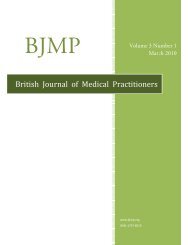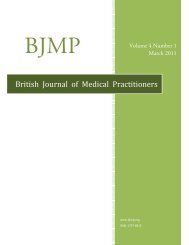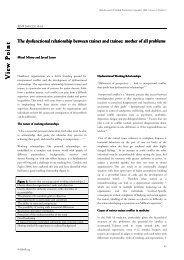R esearch A rticle - British Journal of Medical Practitioners
R esearch A rticle - British Journal of Medical Practitioners
R esearch A rticle - British Journal of Medical Practitioners
Create successful ePaper yourself
Turn your PDF publications into a flip-book with our unique Google optimized e-Paper software.
<strong>British</strong> <strong>Journal</strong> <strong>of</strong> <strong>Medical</strong> <strong>Practitioners</strong>, March 2013, Volume 6, Number 1<br />
can have brief abnormal stimulus evoked pain like allodynia or<br />
hyperalgesia. Some patients also complain <strong>of</strong> brief lancinating<br />
pains described as electrical or lightening pains which can be<br />
spontaneous or evoked. The symptoms typically start in the toes<br />
and feet and ascend in the lower limb over years and are worse<br />
at night. Diabetic distal polyneuropathy is typically described in<br />
glove and stocking distribution but the upper limb involvement<br />
is rare. On examination there can be paradoxically reduced<br />
sensation to light touch and pin prick in the area <strong>of</strong> pain.<br />
Examination can also show features <strong>of</strong> allodynia (pain caused by<br />
a stimulus that does not normally cause pain), hyperalgesia<br />
(pain <strong>of</strong> abnormal severity in response to a stimulus that<br />
normally produces pain), hyperpathia (painful reaction to a<br />
repetitive stimulus associated with increased threshold to pain),<br />
dysaesthesia (unpleasant abnormal sensation as numbness, pins<br />
and needles or burning), paraesthesia (abnormal sensation<br />
which is not unpleasant) or evoke electric shock like pains.<br />
There can be features <strong>of</strong> peripheral autonomic neuropathy<br />
including vasomotor changes like colour changes <strong>of</strong> feet which<br />
can be red, pale or cyanotic and temperature changes like warm<br />
or cold feet. With autonomic neuropathy there can also occur<br />
trophic changes which includes dry skin, callouses in pressure<br />
areas and abnormal hair and nail growth and sudomotor<br />
changes involving swollen feet with increased or decreased<br />
sweating. Mechanical allodynia is the most common type <strong>of</strong><br />
allodynia, but there can be thermal allodynia described as cold<br />
or warmth allodynia. Patient <strong>of</strong>ten describes cold allodynia as<br />
the pain getting worse in cold weather and warmth allodynia<br />
can make the patient keep the effected limb cool by using fan or<br />
ice bags. There can be reduced joint position sense, reduced<br />
vibration sense, reduced temperature sensation and reduced<br />
ankle jerks.<br />
Diagnosis:<br />
The diagnosis <strong>of</strong> PDN can be made by clinical tests using<br />
pinprick, temperature and vibration perception (using a 128-Hz<br />
tuning fork). The feet should be examined for ulcers, calluses<br />
and deformities. Combinations <strong>of</strong> more than one test have<br />
>87% sensitivity in detecting PDN. Other forms <strong>of</strong><br />
neuropathy, including chronic inflammatory demyelinating<br />
polyneuropathy, B12 deficiency, hypothyroidism and uraemia,<br />
occur more frequently in diabetes and should be ruled out. If<br />
required these patients should be referred to a neurologist for<br />
specialized examination and testing 3 .<br />
Treatment Options:<br />
US Food and Drug Administration has approved duloxetine in<br />
2004 and pregabalin in 2005 for the treatment <strong>of</strong> painful DPN.<br />
Amitriptyline, nortriptyline and imipramine are not licenced for<br />
the treatment <strong>of</strong> neuropathic pain.<br />
NICE clinical guidance on pharmacological management <strong>of</strong><br />
neuropathic pain in adults in non-specialist settings as shown in<br />
Figure 1, recommends duloxetine as the first line treatment,<br />
which if contraindicated amitriptyline is suggested to be the<br />
first line. Second line treatment is amitriptyline or pregabalin.<br />
Pregabalin can be used alone or in combination with either<br />
amitriptyline or duloxetine, which if ineffective the patient<br />
should be referred to specialist pain services. While awaiting the<br />
referral tramadol can be started as the third line treatment.<br />
NICE also recommends that these patients should be reviewed<br />
to titrate the doses <strong>of</strong> the medication started, to assess the<br />
tolerability, adverse effects, pain reduction, improvement in<br />
daily activities, mood, quality <strong>of</strong> sleep and the overall<br />
improvement caused by the medication as reported by the<br />
patient 4 .<br />
The Mayo clinic recommends 5 the first tier <strong>of</strong> drugs for<br />
peripheral diabetic neuropathy are duloxetine, oxycodone CR,<br />
pregabalin and tricyclic antidepressants. The second tier <strong>of</strong><br />
drugs iscarbamazepine, gabapentin, lamotrigine, tramadol and<br />
venlafaxine extended release. The topical agents suggested are<br />
capsaicin and lidocaine.<br />
“Evidence Based guideline on treatment <strong>of</strong> Painful Diabetic<br />
Neuropathy”, was formulated by American Academy <strong>of</strong><br />
Neurology; American Association <strong>of</strong> Neuromuscular and<br />
Electrodiagnostic Medicine; American Academy <strong>of</strong> Physical<br />
Medicine and Rehabilitation. A systematic review <strong>of</strong> the<br />
literature between time period 1960 to 2008 was carried out.<br />
The review included the a<strong>rticle</strong>s which looked at the efficacy <strong>of</strong><br />
a given treatment either pharmacological or nonpharmacological<br />
to reduce pain and improve physical function<br />
and quality <strong>of</strong> life (QOL) in patients with PDN. They<br />
subsequently recommended that Pregabalin is established as<br />
effective and should be <strong>of</strong>fered for relief <strong>of</strong> PDN (Level A).<br />
Venlafaxine, duloxetine, amitriptyline, gabapentin, valproate,<br />
opioids (morphine sulfate, tramadol, and oxycodone controlledrelease),<br />
and capsaicin are probably effective and should be<br />
considered for treatment <strong>of</strong> PDN (Level B). Other treatments<br />
have less robust evidence or the evidence is negative. Effective<br />
treatments for PDN are available, but many have side effects<br />
that limit their usefulness, and few studies have sufficient<br />
information on treatment effects on function and quality <strong>of</strong><br />
life 6 .<br />
Non-pharmacological techniques:<br />
Letícia et al. following their literature review on therapies used<br />
for PDN concluded that for non-pharmacological techniques<br />
like acupuncture, reiki, photic stimulation, electromagnetic<br />
stimulation <strong>of</strong> neural electrical stimulation, laser therapy, there<br />
is a lack <strong>of</strong> consensus about their effectiveness and there is<br />
scarce knowledge about them. They suggested new r<strong>esearch</strong>es,<br />
including treatments for a longer period <strong>of</strong> time, with dosimetry<br />
control, and representative samples are necessary to discover the<br />
actual importance <strong>of</strong> these therapies for pain relief 7 .Spinal Cord<br />
Stimulators have however been shown to be effective and safe in<br />
severe resistant cases 8,9 .<br />
BJMP.org<br />
13







